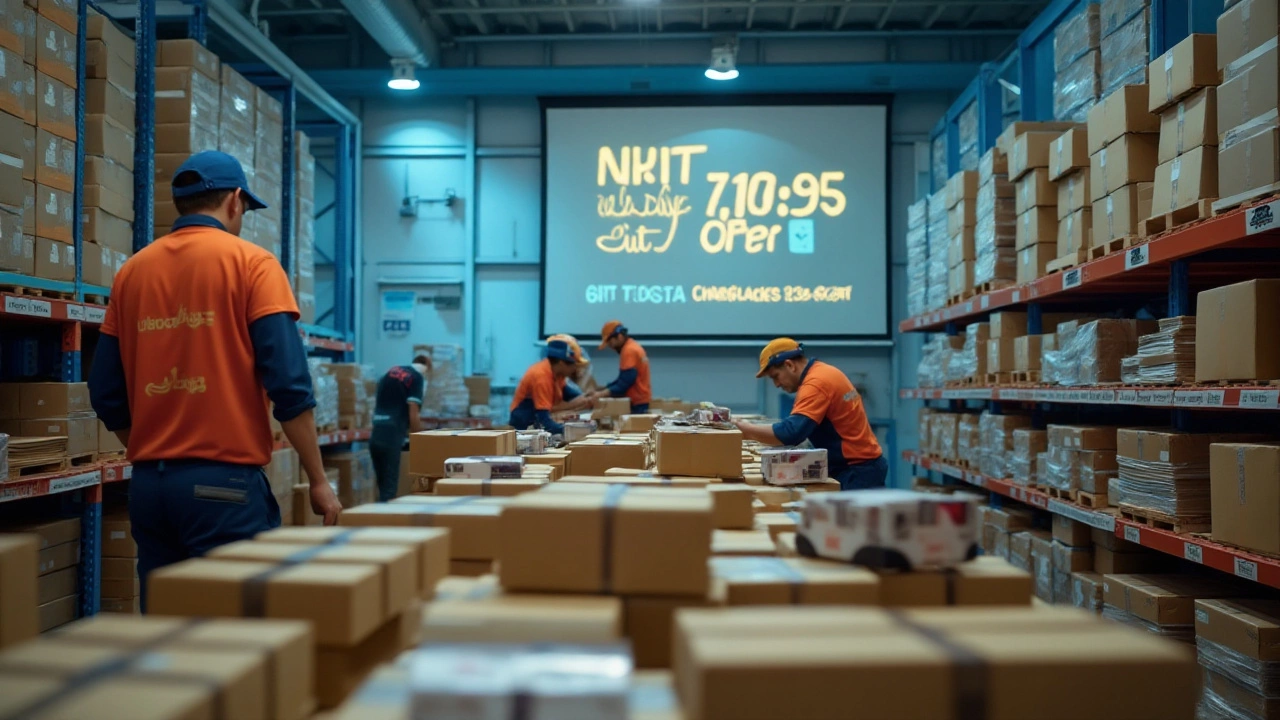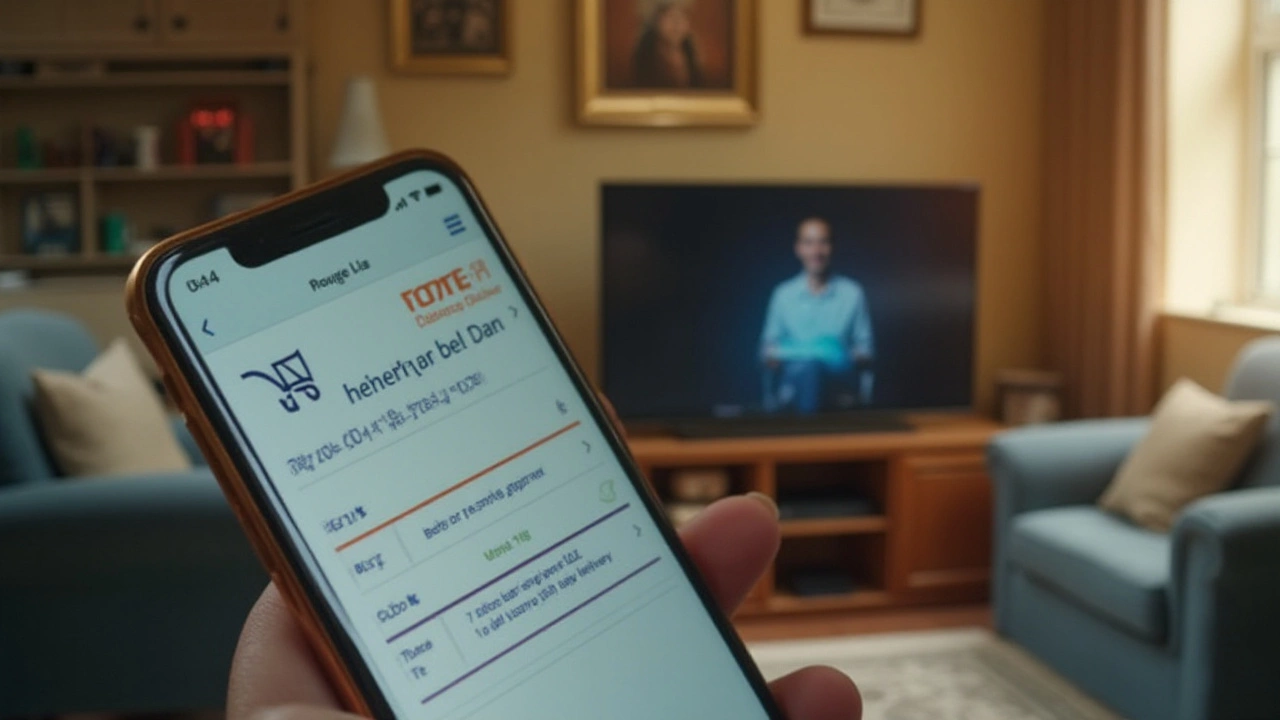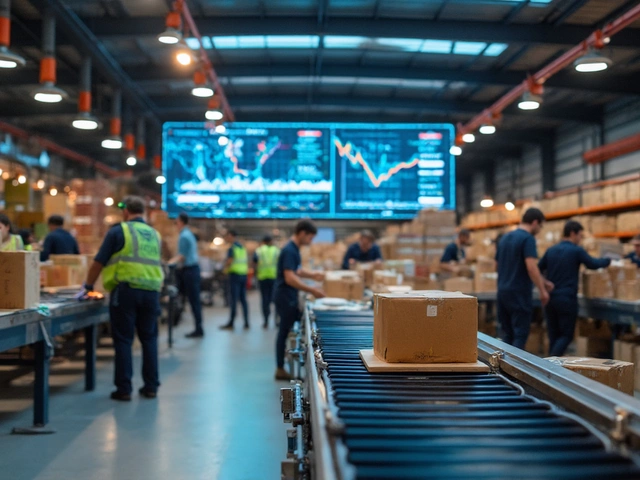Next day delivery has become a staple in the world of online shopping. But, for it to work like magic, understanding the cut-off times is essential. These times mark the deadline for placing an order if you want it to be shipped and delivered by the next day.
The significance of these deadlines cannot be overstated. They act as a checkpoint in our busy schedules, ensuring parcels move smoothly from warehouse to our doorstep. With different couriers and retailers having various cut-off times, it’s a bit like learning a new dance – once you know the basic steps, everything flows more easily.
Whether you're buying a last-minute gift or restocking essential supplies, each moment before the cut-off counts. Knowing exactly when to place an order could mean the difference between a timely delivery or an unexpected delay. So, let’s dive into what affects these all-important cut-off times and how you can navigate them like a pro.
- Importance of Cut-Off Times
- Factors Influencing Cut-Off Times
- Courier-Specific Guidelines
- Retailer Policies and Exceptions
- Tips for Meeting Deadlines
- Common Mistakes to Avoid
Importance of Cut-Off Times
The concept of next day delivery hinges on one simple yet crucial element: the cut-off time. This deadline determines whether a package can feasibly travel from point A to point B within a mere 24 hours. As consumer expectations escalate with the promise of rapid deliveries, businesses and logistics professionals must place significant importance on understanding and managing these critical timelines. A clearly defined cut-off time is the lynchpin that aligns the order placement with the logistics process, ensuring that customers receive their products promptly and without a hitch.
Getting the timing right is especially vital in today's retail landscape, where speed often trumps other factors in the purchasing decision. In fact, a McKinsey survey revealed that approximately one in four customers are willing to pay significantly more for same-day or next day shipping. This is a clear indication of how much value consumers place on rapid delivery. The expectancy of having access to products almost immediately after ordering has revolutionized the operational strategies within eCommerce and retail sectors, and showcasing visible, reliable cut-off times has become the norm rather than the exception.
Retailers using major couriers and postal services need to synchronize their operations with these services' schedules. Prominent courier companies such as DHL, UPS, and FedEx have specific cut-off times that can vary based on location, service type, and day of the week. These intricacies require careful consideration and planning from businesses to avoid failed deliveries. Imagine, for instance, a small business that promises next day delivery but misses the courier's cut-off time due to poor planning — not only does this result in dissatisfied customers but can also lead to brand damage and potential loss of repeat business.
On the flip side, well-managed cut-off times can significantly enhance customer satisfaction. Efficient logistics and transparent communication ensure that consumers can trust a brand's delivery promises. In the world of eCommerce, where trust plays a pivotal role, showcasing accurately maintained cut-off timings can set a retailer apart from its competitors. Patricia Hume, a logistics expert, mentions,
"Understanding and communicating your cut-off times with precision is not just about operations; it's about building trust with your customers."Such trust translates into positive reviews, recommendations, and a solid foundation for customer loyalty.
Further adding to the importance of cut-off times is the impact they can have during peak shopping periods, like holiday seasons or major sales events. Navigating these busy times successfully depends heavily on accurately managing cut-off times to maintain the swift movement of goods. By effectively prioritizing the alignment of marketing campaigns and logistics strategies to these time frames, businesses can capitalize on heightened consumer demand without the risk of not delivering on time.
An interesting trend observed is how some businesses now offer extended cut-off times as a competitive advantage. For example, Amazon Prime's two-day delivery often competes with other retailers by offering later cut-offs to entice shoppers who thrive on spontaneity. Such strategies allow businesses to cater to different consumer behaviors, ultimately leading to a boost in sales and customer satisfaction. Managing cut-off times effectively thus requires not only logistical adeptness but also a deep understanding of customer demands.
Factors Influencing Cut-Off Times
Understanding the factors that drive cut-off times for next day delivery can significantly improve the chances of having your package arrive as expected. These deadlines depend on a range of variables, including logistical constraints and geographical realities. For instance, the distance between the shipping point and destination plays a huge role; a longer distance often means an earlier cut-off time to allow for all the logistical steps required to deliver a package. In addition, busy urban centers might have later cut-off times due to more frequent pickups and deliveries than rural areas.
Another influencing factor is the specific courier service used. Different couriers have different networks, infrastructure, and capabilities, which can impact their ability to promise and execute a next day delivery. Some couriers operate their flights, while others rely on external airlines, affecting the reliability and efficiency of their delivery promises. For example, major players like DHL and FedEx have wide-reaching networks enabling them to handle tighter cut-off times compared to smaller regional carriers.
Retailer-Specific Policies
Retailers also have a significant say in determining cut-off times because they often base these deadlines on their internal processing speeds. Some major online platforms, due to their sophisticated automation and logistics systems, offer late cut-off times even up until late evening hours, allowing customers greater flexibility. However, smaller businesses might have earlier deadlines due to limited staff and resources. It is also worth noting that during peak seasons like Christmas or Valentine's Day, cut-off times may adjust to account for increased order volumes. According to industry insights shared by logistics expert James Crimmins, "Retailers often find themselves balancing between customer expectations and operational realities, making cut-off times a moving target."Weather and Other External Factors
Let's not forget the role of external factors such as weather. Adverse conditions such as snowstorms or flooding can disrupt transport networks, prompting couriers to adjust their cut-off times. Additionally, social and political events sometimes necessitate changes in these deadlines. For example, during the COVID-19 pandemic, many couriers revised their operations, affecting both cut-off times and delivery estimates. Having this multifaceted comprehension of the elements influencing cut-off times allows for more informed and strategic planning when it comes to shipping and receiving goods.
Courier-Specific Guidelines
In the bustling world of logistics, each courier service has its own rules for next day delivery, which are crucial for businesses and customers alike. Understanding these guidelines can significantly impact how smoothly your items move from origin to destination. One might think all delivery services are cut from the same cloth, but each comes with its own quirks. Recognizing these nuances can prevent unwelcome surprises. Couriers like FedEx, UPS, DHL, and even regional services like New Zealand Post each have different cut-off times for next day delivery. These varied times can depend on the destination or type of service chosen, among other factors.
If we take a closer look at a major courier like FedEx, their cut-off timeliness can range depending on the specific service. FedEx guarantees next-day shipments within country borders if you place your order before their designated timeline, which is often around late afternoon for most urban areas. In contrast, UPS tends to have a slightly earlier timeline—say around 3 PM—especially when dealing with **shipping deadlines** for more remote locations. A crucial tip is always to check with the courier’s customer service or their official website to confirm the exact cut-off time for your specific situation.
Many couriers have developed user-friendly mobile apps and online portals, aiming to keep their clients abreast of the latest deadlines. These digital tools can help track package location and estimate delivery times right to the minute. For example, DHL's app provides real-time updates and alerts to ensure you never miss an important cutoff. As Nick Robertson, an industry expert, puts it,
"In logistics, time is money. Couriers are constantly refining their technology to keep deliveries punctual and clients happy."Understanding your courier's guidelines can save valuable minutes in a world where even seconds can make a significant difference.
It's also important to note the influence of the day of the week on cut-off times. Knowing that couriers may have earlier deadlines on Fridays to ensure delivery by Monday rather than Saturday is beneficial, although weekend delivery options are increasingly available for a premium fee. Sometimes, even weather conditions and holidays can cause shifts in expected deadlines. Keeping abreast of such affecting factors via official courier notifications can aid in minimizing disruption to your planned timeline.
Here's a glimpse of some hypothetical statistics that may further enlighten our understanding:
| Courier | Average Cut-Off Time | Next Day Delivery Coverage |
|---|---|---|
| FedEx | 5:00 PM | 90% |
| UPS | 3:00 PM | 85% |
| DHL | 4:00 PM | 95% |
Staying informed with the specific guidelines each courier provides will arm you with the knowledge you need for a timely and efficient delivery experience. It's almost like having a logistical map leading you through intricate pathways directly to your doorstep.
Retailer Policies and Exceptions
The landscape of next day delivery is not a one-size-fits-all situation, and that's where retailer policies come into play. Each retailer might have a unique approach to cut-off times, influenced by their logistical capabilities or partnerships with specific courier services. Some large online marketplaces, like Amazon, which are known for their wide-reaching delivery networks, offer same-day dispatch for orders placed by certain times, often claimed to be as late as 10 PM in metropolitan areas. However, smaller retailers might need more lead time due to varying resources, so their cut-off times might be earlier in the day.
In fact, it's not uncommon for retailers to implement a layered approach to cut-off times. For example, they might promise next day delivery on weekdays but adjust the policy slightly over weekends or public holidays. Retailers often emphasize this differentiation upfront to set clear expectations and avoid customer dissatisfaction. Sometimes, delivery windows can also depend on the availability of certain products; high-demand items may have stricter cut-off schedules due to limited stock or complex handling requirements.
Promotional events, like Black Friday or Cyber Monday, can introduce temporary exceptions to usual delivery promises. Retailers might either extend cut-off times, anticipating higher demand and wanting to ensure sales, or restrict delivery as shipping networks become strained. This duality calls for consumers to be extra vigilant during these shopping sprees to ensure timely deliveries. One fascinating pattern observed is how luxury brands, offering bespoke products, might allow wider order windows or flexible delivery timelines, compensating with personalized customer service. Coincidentally, these policies often align with customer expectations that their exceptional purchase warrants an exceptional delivery service.
Exceptions Due to External Factors
Certain external factors can also necessitate exceptions to the supposed cut-off time. Delivery services are subject to delays stemming from adverse weather conditions or unexpected disruptions like strikes or global pandemics, which sometimes compel retailers to adjust their policies in response. During such global crises, some companies have been noted to enhance communication channels, proactively informing customers about potential disruptions and offering alternate solutions to cater to urgent orders. Retailers using augmented technology and AI have managed to fine-tune their logistics even amid these challenges.
"Retailers often have to adapt swiftly to unforeseen circumstances, ensuring that customer trust is not compromised. It's a dynamic process." - Delivery Logistics Magazine
Understanding a retailer's delivery policy is genuinely vital. To get a clearer idea of what to expect, it's always wise to check out the 'delivery information' section on a retailer's website before placing an order. With these insights, consumers are better primed to enjoy the conveniences of online shopping with fewer hiccups and uncertainties.

Tips for Meeting Deadlines
Whether you're a customer eagerly awaiting a purchase or a business ensuring products reach swiftly, mastering the art of meeting cut-off times for next day delivery is pivotal. The first step is understanding that time really is of the essence here. Shipping demands precision and can be akin to catching the last bus for the day. Once the window closes, there’s no turning back. Start by setting reminders for yourself. Utilizing your phone's alert system can be your best ally in these situations. Setting an alarm an hour before the deadline allows you enough time to finalize your decision.
One must also consider the specific guidelines provided by the courier service you choose. Each company operates under a unique framework of logistics. They often display the cut-off time very clearly on their service pages, serving as a helpful guideline. However, it can be easy to overlook this crucial information. Double-check your local time, especially if the retailer operates in a different time zone. This can prevent unfortunate mishaps where orders fail to meet the cut-off and sit wearily in wait.
According to a report by eCommerce Times, aligning your purchases with retailer policies boosts delivery chances by up to 25%. Understanding these policies can often make or break the timely arrival of your package.
Another golden rule is preparation. Always have your payment details ready to prevent last-minute delays. Scrambling to find your credit card can steal precious minutes and change the fate of your delivery. Also, regular items that you often buy should be bookmarked or saved in a wish list so you can quickly add them to your cart when needed. This way, the transaction is more streamlined.
Collaborate closely with your chosen courier service. Subscription to notifications can often shed light on any sudden changes, like expected delays due to adverse weather or unexpected strikes. Some courier services provide apps that notify customers of crucial updates, allowing for better management of expectations. Engaging with customer service lines during point-of-need situations could also amend potential issues before they blend into bigger problems.
Plan in Advance
Planning ahead can be just as essential as addressing daily shipments. Maintaining a consistent check on your average purchase cycle is key to anticipating needs before they become urgent. Johnson Analytics notes that forethought in this regard enhances customer satisfaction by nearly 30%. Knowing when essentials are required means you can synchronize orders closer to cut-off times without anxiety-ridden impromptu decisions that lead to mistakes.
Finally, leveraging technology by using noise-canceling headphones during tight decision-making can foster improved focus. This removes distractions allowing all thought energy to channel towards successfully meeting deadlines. Restful night sleep the day prior can reduce reaction time in assessing what needs to be done to deliver successfully. Comprehensive confidence and effective strategizing are instrumental components in guaranteeing you consistently meet your next day delivery goals, always beating the cut-off.
Common Mistakes to Avoid
Navigating the intricacies of next day delivery can sometimes feel like threading a needle in the dark. There are a few common pitfalls that consumers frequently encounter when trying to ensure their packages arrive on time. One major mistake is forgetting to check the specific cut-off times of the courier service being used. Not all delivery services operate on the same schedule, and these times can vary significantly depending on the region or even the day of the week. This oversight can lead to delays that are both frustrating and easily avoidable.
Another common error is underestimating the impact of public holidays and local events on delivery schedules. These occasions can skew the usual timelines, causing unexpected delays. Retailers often post notices about these disruptions, but it’s crucial to stay informed and plan accordingly. Ignoring these alerts can lead to unexpected hiccups in your delivery schedule. Additionally, placing orders during peak shopping seasons like Black Friday or the festive Christmas rush without allowing extra time can result in late deliveries, due to the sheer volume of parcels flowing through logistics networks.
"The key to timely deliveries lies in being proactive, not reactive," advises logistics expert Karen Mulligan, whose insights have helped optimize delivery strategies for several global retailers.
A less obvious mistake involves neglecting to double-check the details you provide when placing an order. An incorrect address, an outdated contact number, or even a misspelled name can cause snafus in the smooth transit of your package. Ensuring that all details are correct before confirming an order might seem like a no-brainer, yet it's a step many overlook in the haste of purchasing the last item in stock. This simple precaution can save time and headaches.
Lastly, relying solely on standard policies without considering special exceptions set by the retailer can lead to mismanaged expectations. Some sellers might have different cut-off times or additional charges for next day delivery on certain products, particularly in niche markets. It's always wise to delve into the small print and possibly even contact customer service for clarification. This extra step ensures no surprises pop up when you're eagerly tracking your parcel.
Pro Tip: Keep a Personal Checklist
Creating a personal checklist prior to order placement can be quite helpful. Start by listing the known shipping deadlines and the precise cut-off time relevant to your order. Include reminders to check for local events or holidays. Most importantly, ensure your account information is up to date before hitting 'order'. This preventive measure aligns all moving parts, decreasing the likelihood of a slip-up.





